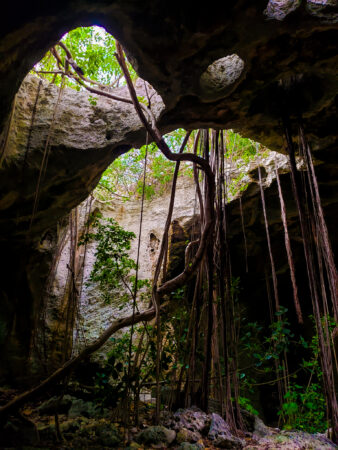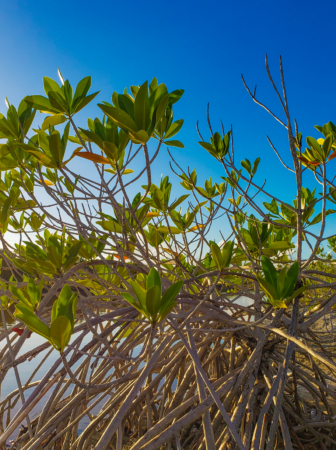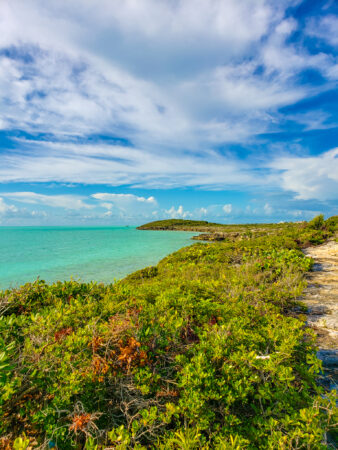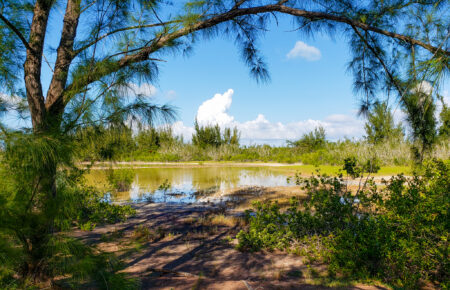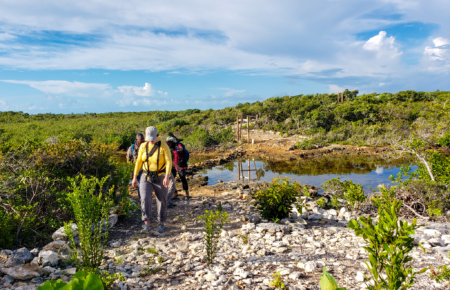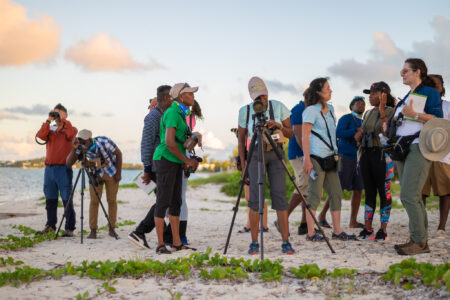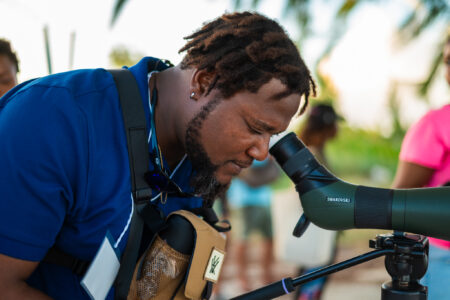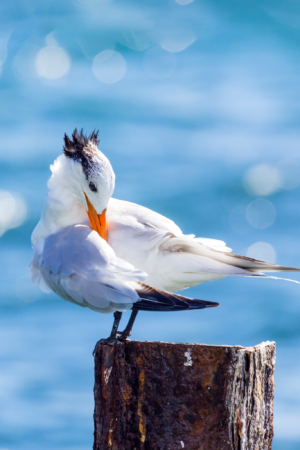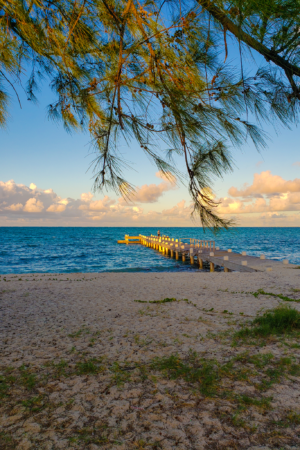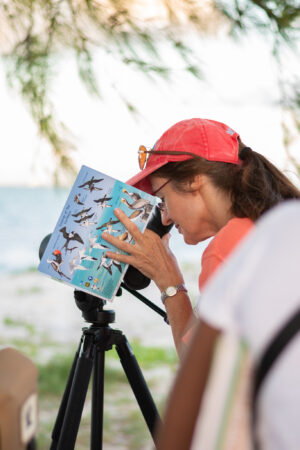“A veritable mecca for waterbirds and shorebirds.” “One of the most important areas for wintering Piping Plovers in the entire Caribbean.” Those are not exactly the mental images that come to mind when one thinks about tourism in the Turks and Caicos Islands (TCI)—you would be forgiven for instead immediately conjuring visions of sun, sea, and brilliant white sand—but indeed, this incredible Caribbean biodiversity hotspot offers so much more! Thanks to the Caribbean Birding Trail, and 24 passionate, newly certified bird guides trained to bring the hidden side of TCI to the ever-expanding birding tourism market, this image is about to change. It’s time to meet the Turks and Caicos that only insiders know—and the guides who will make booking a birding tour a quintessential part of the TCI experience.
Sun, sea, sand, and …sublime salt ponds?
The natural beauty of the Turks and Caicos Islands is reflected in the nation’s tourism motto “Beautiful by Nature,” and indeed, no superlative feels adequate to effectively capture its wondrous magic. TCI’s coastlines immediately standout as being the textbook definition of idyllic. The powdery white sand is flecked with coral pinks, whilst the water offers mesmerizing combinations of electric blue and turquoise. Look further and feast your eyes on the islands’ other defining features—a range of fantastic wetlands including picturesque salinas and salt ponds, submerged mangroves, miles and miles of tidal flats and sand banks; intriguing limestone caves; and verdantly green dry tropical forests.
Spend some time contemplating this rich tapestry of blues and greens, and in many-splendored flashes of stunning purples, deep reds, sunny yellows, and intensely-pigmented pinks, the real secret of these environments will be revealed—their biodiversity! Glittering hummingbirds, flamboyant flamingos and darting yellow warblers—TCI’s various ecosystems provide critical habitats for a grand diversity of birds. Resident herons, egrets, shorebirds, ducks, seabirds, and landbirds are common sights at TCI’s wetlands. In addition to the islands’ surface area being made up of over 50% wetlands, the country can boast of being home to the largest island in the West Indies undisturbed by humans. TCI’s ecosystems are also a crucial lifeline for winter migrants who can often be easily observed busily attending to the vital business of eating, eating, eating, (and resting!) to refuel their bodies to carry on in their southward migration.
A match made in Heaven—Sustainable Economic Development meets Biodiversity Protection—in thoughtful, authentic ecotourism where conservation is at heart of the offer
While the TCI Government has designated significant areas for conservation, the full potential of these areas for ecotourism has yet to be tapped. The TCI tourism community has not fully recognized the benefits that nature conservation can bring. The industry is currently focused on high-end/luxury travelers on the main inhabited island of Providenciales; the other inhabited islands of North and Middle Caicos, Grand Turk, South Caicos, and Salt Cay have not benefited from the massive and continued growth of tourism. Away from Providenciales, there are currently limited employment and business opportunities, unless these take the form of large-scale developments with their attendant negative impacts on the natural environment and cultural heritage. New employment opportunities, compatible with natural resource conservation, are urgently needed.
It was against this backdrop of this untapped opportunity for development, the drive to protect TCI’s tremendous biodiversity—and the potential to marry these seemingly competing areas in a way that empowered the TCI community by supporting truly sustainable livelihoods, that the Caribbean Birding Trail (CBT), set its focus on the Turks and Caicos Islands in late 2023. The CBT is a flagship program of BirdsCaribbean that emphatically recognizes that we can unify conservation with business to shape a Caribbean where tourism is harnessed as a force for environmental preservation and sustainable development, rather than the exploitation and degradation of habitats.
BirdsCaribbean Executive Director, Dr. Lisa Sorenson explains, “Globally, the tourism market for wildlife watching and wildlife photography is growing, and bird tourism is a significant part of this market. In the US, the 2022 National Survey of Fishing, Hunting, and Wildlife-Associated Recreation lists the national bird watching audience at a whopping 96.3 million citizens—a segment that has grown dramatically in the last few years and continues on an upward trend; while in the UK, the Royal Society for the Protection of Birds (RSPB) claims that around 6 million United Kingdom residents are regularly engaged in birdwatching. The Caribbean Birding Trail seeks to attract these markets to the Turks and Caicos Islands and the wider Caribbean. Integral to this is having well-trained guides who can help connect ecotourism travelers with the cultural and natural resources of the islands, creating meaningful and authentic experiences.”
A dynamic team of trainers, bearing birding gifts!
From October 23 to 27, on Providenciales, we joined forces with the Turks and Caicos National Trust, with additional support from the Department of Environment and Coastal Resources (DECR) and the Royal Society for the Protection of Birds (RSPB), to train twenty-four guides with the goal of building a sustainable tourism market in TCI that focuses on birds, nature, and heritage.
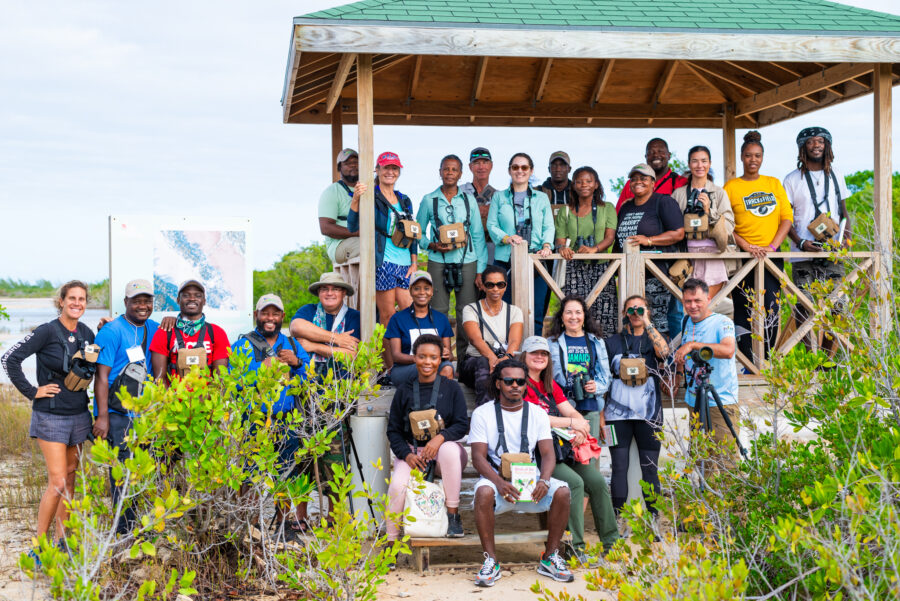
The intensive five-day workshop was led by Dr Lisa Sorenson, certified interpretive trainers from the National Association of Interpretation (NAI), Venicio (Beny) Wilson and Rick Morales, and CBT Project Leader, Holly Robertson. Participants explored the importance of preserving the Turks and Caicos Islands’ birds and nature while strengthening the islands’ local ecotourism sector. Modules included the Basics of Bird ID Techniques, which examined size and shape, field marks, behavior, habitat, and birdsongs; How to Use Binoculars and Spotting Scopes; Avian Ecology; and Guiding and Interpretation Techniques.
Of course, you can’t go birding without your gear—and on day one of the course, Executive Director Lisa Sorenson closed her introductory Birding 101 session with the most wonderful surprise! All participants received a comprehensive and thoughtfully curated package which included Vortex binoculars, a Birds of the West Indies field guide, bird ID cards, a CBT hat, an endemic birds of the Caribbean bag, and many other resources. BirdsCaribbean ensured that new guides had all the tools they needed to support them on their burgeoning birding guide journeys. One participant exclaimed, “It’s like Christmas!! This is amazing!”
Out of the classroom and into the field!
Armed with a host of new bird ID skills, new binoculars and an enviable collection of field ID cards and guides—there was only one place left to go for our excited cohort—absolutely everywhere! Each day of training featured field trips to the best and most accessible birding sites on Providenciales, giving participants ample opportunity to learn and practice bird ID, benefit from practical in-the-field training from Beny and Rick on guiding techniques, and to familiarize themselves with the Turks and Caicos Islands’ top birding spots.
Our first spot, Wheeland Pond, easily became a crowd favorite thanks to a flock of resident Black-necked Stilts who greeted us with elegant poses on each of our visits there. Wheeland Pond is a wetland which provides excellent habitat for both breeding and migratory shorebirds, with resident and migratory North American songbirds using the surrounding scrub and woodland. Its complex system of natural saline ponds and manmade water-filled pits, a haven for birdlife, provided participants with great opportunities to practice distinguishing between tricky shorebirds (and mastering some easier ones thanks to enthusiastic Ruddy Turnstones and Killdeer) and even trickier fall-plumaged warblers (we spotted 8 different species!). Wheeland also provided one of the week’s most exciting birding moments for participants—a rare sighting of the elusive and shy Sora! Everyone was lining up at the scopes to get a look at this bird and its striking yellow bill!
Seabirds and scopes! In a beautiful setting…
Spotting scopes are a vital ticket to getting the front row seat to the most intimate views of bird behavior—and they’re a great tool for guides wanting to give their guests an incredible birding tour. Participants learned the essential tricks of scope setup and how to manage scope usage within a tour group from the seasoned guides. Pro-tip: Set the height of the scope to accommodate the shortest person in the group! Getting the opportunity to practice these skills by locating seabirds (Royal Terns abounded!) amidst the sublime backdrop of Blue Hills Jetty at sunset was the ultimate plus.
Painting a picture: A lesson in interpretive guiding
Back in the classroom, interpretive trainers Beny and Rick, who work as guides in Panama, wowed the participants with in-depth sessions on the birding market, communication skills, and the principles of environmental interpretation*. Participants experienced theory put into practice with a birding field trip to Bird Rock Point Trail. Along this picturesque walk, which winds through a variety of terrestrial and wetland habitats, trainers led smaller groups through the nuances of how to manage a tour. Questions addressed included how to keep the group together; balancing the needs of photographers in the group with those more focused on birdwatching; and how to cater to different skill levels. These were interrupted by the ever-exciting, “Did you see that?!” Trainers and participants alike were thrilled to confirm a sighting of a Rose-breasted Grosbeak—a rare spotting for TCI!
Birds and beyond…
The training also featured guest lectures from Bryan Naqqi Manco, Assistant Director of Research & Development, DECR, and all-around skilled naturalist/ botanist, who had everyone leaning in with a fascinating presentation on TCI’s endemic flora and fauna, and Simon Busuttil, RSPB Turks and Caicos Operations Manager, who shared information about TCI’s birding sites and conservation issues and the ongoing East Caicos Wilderness Project. The goal of this Darwin Plus funded initiative is the preservation of the natural and cultural heritage of this spectacular wilderness area, the last large-scale wilderness area in the British West Indies, for future generations to enjoy. Training local guides to interpret this area for visitors and locals alike is one of the goals of the CBT Guide Training Workshop. Participants were in awe when, on our field trip just following Bryan’s talk, we were treated to unexpected sightings of two endemics! As if to let us know that they wouldn’t be upstaged by all the birds—the Caicos Pygmy Boa, a TCI endemic, and the Tall Encyclia Orchid, a regional endemic, greeted us to gasps of surprise and appreciation along the Bird Rock Point Trail.
What they learned—five intense days and a multitude of birds later!
After four utterly packed days of learning from the trainers, it was time for the trainees to take the stage! To demonstrate all they had learned that week, the class was tasked with delivering their very own interpretive talk, flavored by their unique perspectives and life experiences. It was deeply rewarding to listen as participants took us on thoughtfully-constructed journeys of discovery. Talks tackled everything from the proper technique to ‘heron-walk’ through mangroves so that you don’t alert fish, a secret handed down through generations of expert bone fishers; to convincing everyone in the group that kitesurfing could easily become their next big adventure, no matter how intimidating it looks; to an inspiring talk about the value of mangroves with the memorable message, “Mangroves don’t need us, we need them.” After an emotionally-charged day of humorous, revealing, and deeply authentic presentations with strong messages, we were happy to congratulate all participants on achieving their Certificates of Completion with flying colors!
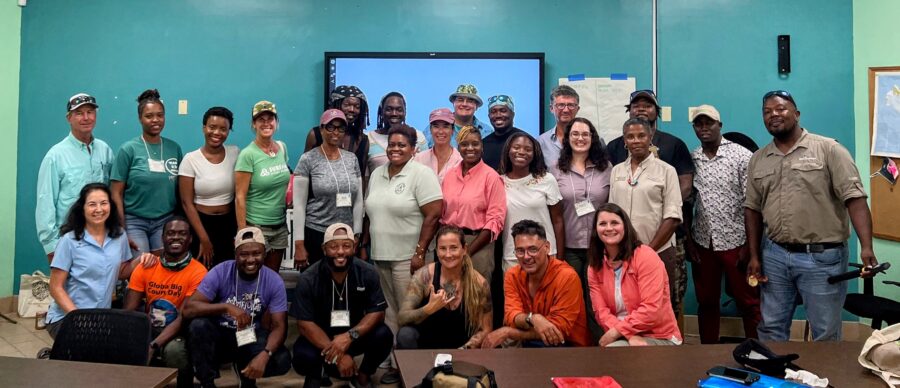
Rave reviews from the participants!
Participants emphatically agreed that the curtain had just fallen on one of the most enriching weeks of their lives. When asked what they most appreciated, enjoyed, or thought was best about the course, one participant commented, “The mix of different people and to be inspired by the facilitators to seek a profitable but sustainable way forward and also a healthy way forward for the spirit. The materials given were awesome! And more than I was expecting.”
“The content of the workshop was outstanding, presented at the right pace and by the best instructors,” said another participant.
One participant who had a lot of experience birding, but not extensive guiding experience explained, “This week was helpful to learn how to participate as a leader for touring, not just for birding, but tours in general.”
Another participant shared, “I think the most interesting thing I learned this week was that there is an entire philosophy behind interpretation—I was not aware of that—and that has really helped me to review what I do in my own tours and to mold them more expertly in the future. This training was really valuable to me—I’ve been guiding for 23 years and I’m really happy to not only learn more about it, but also what I can change to make my programs better! We have a huge opportunity for birding tourism in the Turks and Caicos Islands, we have two endemic subspecies which can be seen nowhere else on earth and we have a couple of other near-endemics which are really easy to see here… Our missing cornerstone for the industry is trained guides—we hadn’t got any, and now we do!”
Keeping in touch—and thank you to our sponsors!
Since the workshop, a “Birdwatchers TCI” WhatsApp group has been formed with participants sharing every day what birds they are seeing, and getting help with bird ID as needed. The group has also planned field trips to continue practicing their bird identification skills—essential for becoming a knowledgeable guide. The group will use eBird Caribbean to document their birding, as well as participate in counts such as the Caribbean Waterbird Census, which will help us to learn more about the bird diversity and important sites for birds on TCI.
Heidi Clarke, Executive Director at the Sandals Foundation (one of the main sponsors of the guide training) said that the Sandals Foundation was, “proud to support this program, which taught participants how to inspire people and engage audiences through storytelling aimed at preserving TCI’s incredible birds and nature.”
“Collectively,” Clarke continued, “We can build a stronger eco-tourism market in TCI that provides sustainable livelihoods and supports environmental conservation. Helping trainees learn about the bird tourism market and how they can tap into this rapidly growing and lucrative ecotourism sector will be beneficial for years to come.”
Acknowledgements: The CBT Interpretive Guide Training was made possible through the generous support of our sponsors and local partners. These include the Sandals Foundation, the Turks and Caicos National Trust, Darwin Plus Initiative, the Turks and Caicos Department of Environment and Coastal Resources, the Royal Society for the Protection of Birds, Marshall Reynolds Foundation, Shika Shika, US Forest Service International Programs, and Vortex Optics.
The TCI CBT Interpretive Guide training is the seventh training to be carried out by BirdsCaribbean. Previous trainings have been held in Grenada, Jamaica, Dominican Republic, Bonaire, Cuba, and St. Vincent and the Grenadines. These guide trainings are integral to advancing the vision of the CBT—connecting people to the extraordinary places, diverse cultures, and people of each island. Through the CBT, we promote natural and authentic experiences that benefit local people and encourage the protection of the Caribbean’s natural resources, including birds and their habitats.
*Interpretation is a purposeful approach to communication that facilitates meaningful, relevant, and inclusive experiences that deepen understanding, broaden perspectives, and inspire engagement with the world around us. (National Association of Interpretation).

